A handsome, affectionate companion and an exceptional hunting partner, the sweet, gentle—and talkative!—redbone coonhound is a wonderful breed for a person or family who loves the great outdoors.
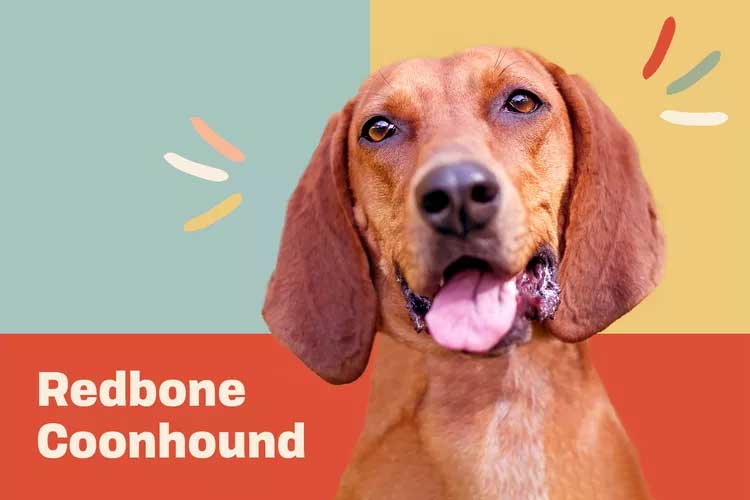
Redbone Coonhound Overview
| OFFICIAL NAME | Redbone Coonhound |
| COMMON NAME | Redbone Coonhound |
| PET HEIGHT | 21 to 27 inches |
| PET WEIGHT | 45 to 70 pounds |
| LIFESPAN | 12 to 15 years |
| GOOD WITH | children, dogs, families |
| TEMPERAMENT | friendly, gentle, outgoing, playful |
| INTELLIGENCE | high |
| SHEDDING AMOUNT | occasional |
| EXERCISE NEEDS | high |
| ENERGY LEVEL | active |
| VOCAL LEVEL | howler |
| DROOL AMOUNT | low |
| BREED GROUP | hound |
| BREED SIZE | medium (26-60 lbs.) |
| COAT LENGTH | short |
| COLORS | red |
| OTHER TRAITS | easy to groom, good hiking companion, high prey drive, loves water, strong loyalty tendencies |
One pleading glance from a precious redbone coonhound and you'll likely be a fan for life. While his reputation as a determined tracking dog is well known, his endearing cuddlebug personality is a pleasant surprise. This tender disposition balanced with boisterous athleticism makes him a terrific companion for a family interested in sporting and nature activities.
Redbone coonhound puppies become exceptional adults when they receive early socialization—especially when entering a home with young children or cats—that helps them quickly grow accustomed to different scents, people, and environments. They're super smart, but if not on the trail of something specific, their easy-going personality means their attention might be diverted in an instant ("squirrel!"). Short, consistent sessions of positive reinforcement training with a dedicated pet parent helps build a strong, responsive relationship.
Appearance
The gorgeous sleek and short ruddy coat of a redbone coonhound dog makes him a handsome pup indeed and sets him apart from other hounds. And while breeders made a specific choice centuries ago to enhance his crimson appearance, some redbones might occasionally have a speck of white on their paws from one of their ancestors.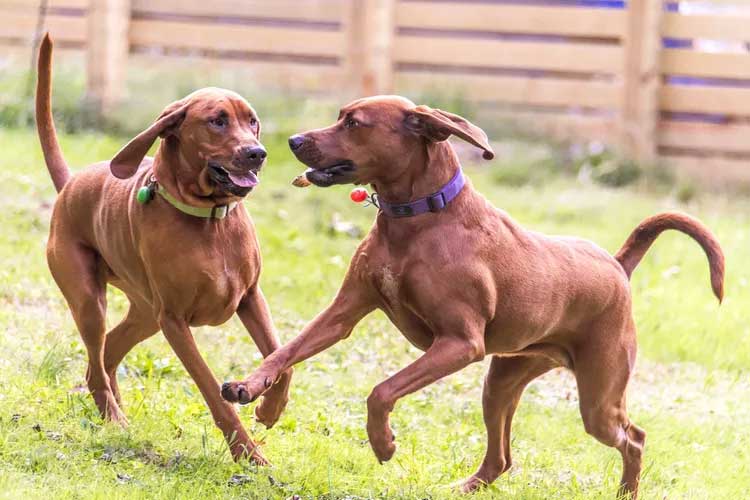
From his cheerful expression to the tip of his narrow, raised tail, a redbone is ready for action! His hindquarters are high and lengthy, which allow him to spring over various terrain or wade through marshes with ease. A slender redbone has the body of an endurance athlete: muscular, lean, and not too bulky.
Generally a medium-sized dog, a female redbone coonhound isn't much smaller in height or less in weight compared to a male: Both measure 21–27 inches tall and weigh 45–70 pounds.
The gentle redbone coonhound's temperament is immediately apparent in his round, bright eyes of hazel, amber, or brown that gaze at you with adoration and eagerness. His silky long ears, so smooth to the touch, curve around a broad muzzle just below the jawline.
Temperament
A redbone coonhound isn't prone to lazing on the front porch for too long, but he does enjoy cozying up with other family members when the day is done. However, before then, he's going to want to sniff and investigate many things! Redbones thrive with proper guidance from experienced dog owners who understand their need for consistent and diverse mental and physical stimulation.Danielle Madore owns Rimfire Kennels in Amboy, N.Y. She says redbones aren't a common breed throughout the U.S., so many people might not have had the pleasure of their company. "They're a medium-energy breed with moments of high energy. Because they're primarily a hunting dog, they can be excitable, and that's where the high energy comes in," Madore says.
A redbone coonhound's temperament, unflappable and friendly with his family, is laser-focused when he's on a night hunt or involved in field events such as water races, bench shows, and hunt tests. These training activities play to a redbone's natural instincts: He was bred specifically to accomplish these challenges.
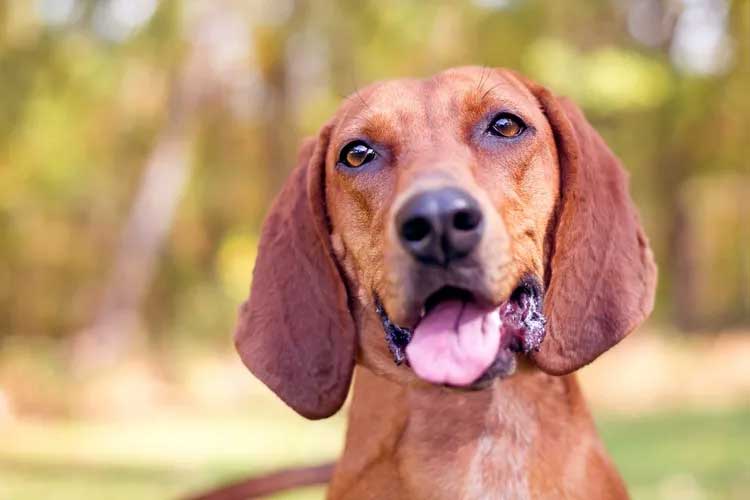
He's also a big ol' clown! "Redbones are full of personality and love to be around people. They can be goofy with serious moments and really love to spend time with their families," Madore says. She adds their fun-loving mentality makes them good family dogs, as they love the company of children—and they see no reason to set themselves apart from you. "A redbone isn't the right choice for you if you expect dogs to stay off furniture or not weasel their way into your bed. Those pleading eyes can be very convincing!" Madore says.
Along with his spurts of energy and silliness is a redbone's tendency to be a chatterbox. "Coonhounds in general are also known for being quite vocal, and can be known to bay or bark when excited or curious," says Alicen Tracey, DVM at Den Herder Veterinary Hospital in Waterloo, Iowa, and a Daily Paws Advisory Board member.
Indeed, their "singing" (also known as baying or crooning) is exactly what hunters hope to hear while out in the field, as it allows them to locate their redbone and his prey. Baying is similar to howling, except it's often more intense with varying tones and pitches. Madore says redbones are chatty in other ways, too, sharing their feelings through "groans, whines, grunts, grumbles, and moans." You won't have to wonder what your redbone thinks: He'll tell you!
Madore adds that while redbone coonhounds aren't incessant barkers, their barks are "loud and noticeable. So be wary about close neighbors or lots of activity in the area that may provoke them to bark." A delivery at the front door or leaves blowing past a window might also attract their attention and prompt a rousing response if they're restless or bored, so it's essential to provide them with enriching engagement.
Madore says redbones will test boundaries, so establish firm guidelines and routines when they're puppies. "They do best with short training sessions throughout the day—we say 'set them up for success, then end the session.'"
Living Needs
Tracey says redbone coonhounds do best in a home with a fenced-in yard to explore scents and play. "Due to the nature of their breed as a scenthound, they do tend to follow their noses, which can sometimes get them in trouble," she says. It's important that play areas have tall, secured fencing that he won't bound over.Also, take time to train a redbone on a proper harness so he doesn't dash off hot on a scent without you during public outings. As Tracey mentioned, a redbone's nose can sometimes lead him to a place he shouldn't be, because he simply can't help but chase after critters. So keep the harness and leash on for casual, non-sporting outings.
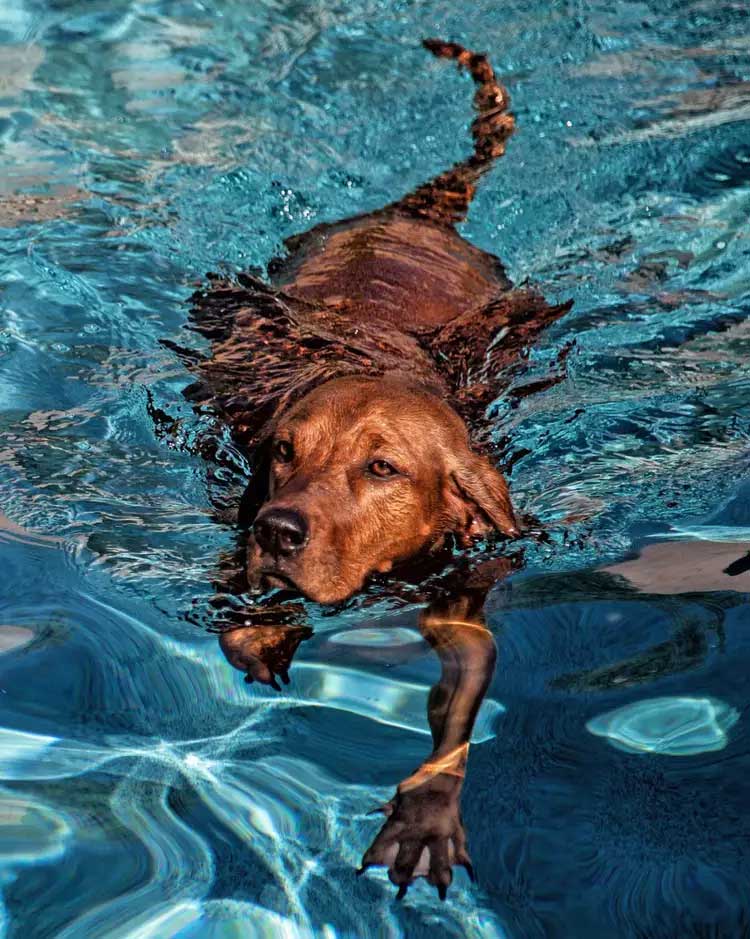
Although they're a laid-back, adaptable breed, redbones need frequent outlets for their bursts of energy and inquisitive natures, and their houndy vocalization might not always please apartment neighbors. But if a new owner combines daily opportunities for active exploration along with proper mental stimulation, a redbone living in a more urban setting might be satisfied with regular invigorating hikes in woods or running trails nearby that tantalize his nose and spark his curiosity.
Placing baby redbone coonhounds in puppy kindergarten shortly after their vaccinations provides a strong training foundation for positive behaviors such as leash walking, coming when called, vocalization cues, and other important life skills. Early socialization also helps them adjust to cats, small dogs, and children in their new surroundings. "They thrive in a home where people want their dogs to be a part of their everyday life, and [they] typically love to be part of a multi-dog household," Madore says.
She also points out that redbones are quite sensitive, so if you happen to adopt an adult with an unknown history, take time to integrate him gradually into your household. This is especially important if you're not sure how he'll react in an environment with cats and other small animals, as some redbones may never lose those track and trail hound instincts. If his background is a mystery, working with an animal behaviorist may help—or perhaps it's best to only adopt a redbone if you have other medium-to-large dogs at home.
Also be aware that not all breeders are created equal, Madore says. "Research and take the time to choose one that has the type of dogs you're looking for in looks and temperament."
Care
As rambunctious as they can be outdoors, redbone coonhounds are fond of their creature comforts, especially in cold weather! An insulating coat or warm sweater for casual outings is an option if they're not running a lot. They might also like a comfy couch or fuzzy bed of their own—but will still likely steal your space!Overall, though, they're a hardy, easy-care breed. A redbone coonhound is not considered to be "hypoallergenic" and his short, sleek coat of coarse hair does shed a bit, but a good weekly brushing helps keep it under control. He doesn't need too many baths unless he's encountered something on the trail, but some owners feel redbones have a "houndy" scent that is unique to them. Use grooming time to check his teeth, too.
Tracey says floppy-eared dogs like redbones are prone to ear infections, so give those silky flaps a good check and cleaning every week. "Coonhound ear infections are typically a mixture of bacteria and yeast and are usually easily treated. It would be wise for coonhound owners to routinely clean their dog's ears to help keep infections at bay," she says. "While it was previously thought that rubbing alcohol/peroxide or vinegar were good cleaners for dog ears at home, these can be painful or toxic if your dog's ear drums aren't intact. Therefore, massaging a small amount of formulized ear cleaner into the ear, and using a cotton ball to remove the excess fluid, is best."
Madore adds the primary maintenance issue redbone pet parents report to her is their dogs' resistance to nail trims. "If not part of the normal routine, they'll avoid having them done at all costs," she says. "We always recommend keeping it up from a very young age, and it will pay off as an adult."
Health
A redbone coonhound's lifespan is usually up to 15 years, as this dog is generally a healthy breed. They sometimes develop skin allergies or cherry eye. Tracey notes a couple of other issues that might occur."Large-breed dogs are commonly known to inherit elbow or hip dysplasia, or deformity of the hip joint, that makes them prone to degenerative joint disease and arthritis," she says.
And because coonhounds are a deep-chested breed, they sometimes develop gastric dilation, or gastric dilatation volvulus (GVD) also known as bloat. "GVD refers to stomach bloat and torsion, whereas gastric dilation refers to gas distension of the stomach without torsion," Tracey says. "Both are serious medical conditions that require immediate veterinary care."
Tracey notes that common signs of bloat include unproductive gagging/retching, stretching out and signs of being uncomfortable, or abdominal distension or pain. "The cause of bloat is difficult to pinpoint, but commonly bloat is seen after eating or drinking large amounts followed by intense exercise."
Madore adds that breeders are also testing for specific heart issues such as canine dilated cardiomyopathy, or DCM, which decreases the heart's ability to pump blood through the vascular system.
History
The ancestry of redbone coonhounds is somewhat of a mystery. The United Kennel Club (UKC) suggests they probably originated in Georgia during the mid-1800s with English foxhound breeder George F.L. Birdsong, who crossed his dogs with bloodhounds and different European hounds, such as the Irish wolfhound and the Grand Bleu de Gascogne.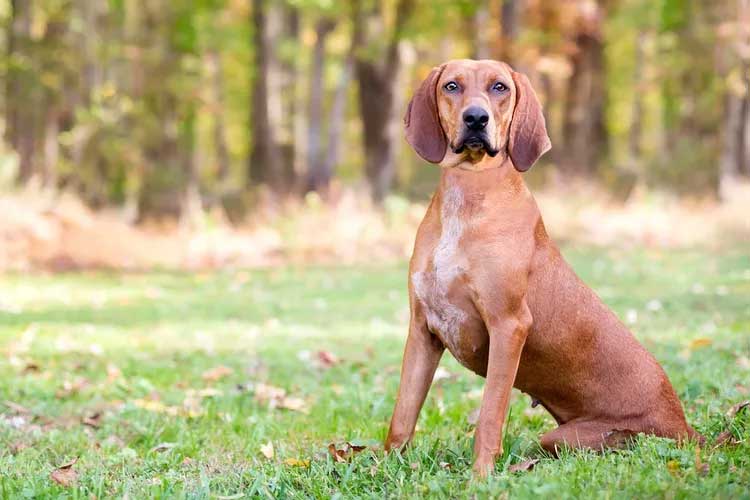
Marked with a dark-colored "saddle," redbones were originally referred to as "saddlebacks." As breeders worked to develop a more true-to-type solid red coat and body conformation, the saddle gradually faded away. The name redbone is considered to not only be a reference to his fur, but perhaps to a notable hound breeder in Tennessee, Peter Redbone, as well.
The primary breeding goal was to create a good scenthound with exceptional tracking abilities. American colonial hunters relied on redbone coonhounds to locate prey that helped feed their families, such as deer, fox, and of course, raccoon, plus larger game such as bobcat, cougar, and bear. A coonhound's keen nose, bountiful endurance, and inherent tenacity enabled him to trail animals easily and, especially in raccoon hunts, "tree" them until the hunters arrived for capture.
The redbone developed a rather good "cold nose," too—which means he has the ability to detect an old scent and follow it. However, his cousin, the bluetick coonhound, is considered by many hunters to be better at this type of tracking.
The UKC registered the redbone coonhound in 1902, and the American Kennel Club did so more than 100 years later, in 2010.
Fun Facts
The most famous literary redbone coonhounds are probably Old Dan and Little Ann in the 1961 children's classic, Where the Red Fern Grows by Wilson Rawls. The film adaptation of the story debuted in 1974. This is one of the most famous lines from the book: "Regardless of all the discouraging talk, the love and belief I had in my little red hounds never faltered. I could see them now and then, leaping over old logs, tearing through the underbrush, sniffing and searching for the lost trail. My heart swelled with pride. I whooped, urging them on." A perfect description of redbones if ever there was one!According to the AKC, redbone coonhounds were popular designer "must have" dogs at one time, as breeders focused on creating a "nearly solid-colored, flashy red dog."
Redbone coonhounds are occasionally confused with other red-hued canines hailing from the AKC's classification of hounds. These include Rhodesian ridgebacks, bloodhounds, and American English coonhounds (sometimes referred to as redtick coonhounds).